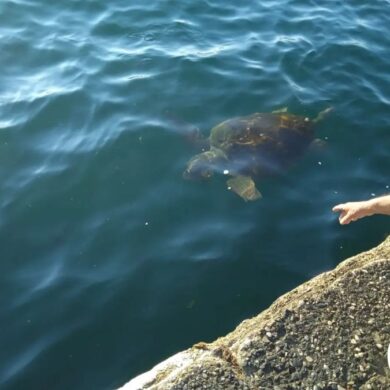By Maria Popova
A poetic meditation on “the sole prescription, not for survival — which is meaningless — but for a society worthy to survive.”
“In all the activities of life,” Aldous Huxley wrote in contemplating how we become who we are, “our whole effort must be to get out of our own light.” Decades later, the novelist and memoirist Vivian Gornick described human creativity as “that rectangle of light and air inside, where thought clarifies and language grows and response is made intelligent.” But what is the nature and origin of that peculiar inner light that makes us human?
That’s what the great anthropologist, philosopher of science, poet, and natural history writer Loren Eiseley (September 3, 1907–July 9, 1977) explores with tremendous insight in a portion of his 1960 book The Firmament of Time (public library) — an uncommonly enchanting and penetrating inquiry into the sometimes fraught, sometimes transcendent, always profound relationship between nature and human nature.

Writing on the centenary of Darwin’s On the Origin of Species, Eiseley considers why evolutionary theory so unsettled humanity — a disquietude which still reverberates through society’s most recalcitrant echelons of creationists, those living fossils of intellectual evolution. He writes:
It is a troubling thought, contend some, to be a man and a God-created creature, and at the same time to see animals which mimic our faces in the forest. It is not a good thing to take the center of the stage and to feel at one’s back the amused little eyes from the bush. It is not a good thing, someone maintained to me only recently, that animals should stand so close to man.
It depends, I suppose, on the point of view.
On my office wall is a beautiful photograph of a slow loris with round, enormous eyes set in the spectral face of a night-haunter. From a great bundle of fur a small hand protrudes to clasp a branch. Only a specialist would see in that body the far-off simulacrum of our own. Sometimes when I am very tired I can think myself into the picture until I am wrapped securely in a warm coat with a fine black stripe down my spine. And my hands would still grasp a stick as they do today.
At such times a great peace settles on me, and with the office door closed, I can sleep as lemurs sleep tonight, huddled high in the great trees of two continents. Let the storms blow through the streets of cities; the root is safe, the many-faced animal of which we are one flashing and evanescent facet will not pass with us. When the last seared hand has flung the last grenade, an older version of that hand will be stroking a clinging youngster hidden in its fur, high up under some autumn moon. I will think of beginning again, I say to myself then, sleepily. I will think of beginning again, in a different way.

Eiseley offers another instance of such visceral awareness of our creaturely nature. Reflecting on a remote region at the borderline of civilization near his hometown, where nightfall engulfs the uncultivated land in mystery, he writes:
Man literally ends here. Beyond lies something morosely violent, of which we have no knowledge, or of which it might be better said that we have a traumatic eagerness to forget. For lurking in this domain is still the nature that created us: the nature of ringing ice fields, of choked forests, of unseasonable thunders. It is the unpredictable nature of the time before the gods, before man had laid hold upon any powers with his mind. It is a season of helplessness that stirs our submerged memories and that causes us to turn back at twilight to the safe road and the lights of town. Behind us whisper the ancient, uncontrollable winds. An animal cries harshly from the dark field we refuse to enter. But enter it we must, though the effort lifts a long-vanished ruff of hair along our nape. This is man’s place of birth, this region of inarticulate terror — and this is the story of how he came through the clouds of forgetfulness to find himself in a world which has vanished.
And yet what was born in that dark field of terror, gestated in the womb of time, was the singular and inextinguishable inner light of our humanity. Eisely writes:
Looking so, across the centuries and the millennia, toward the animal men of the past, one can see a faint light, like a patch of sunlight moving over the dark shadows on a forest floor. It shifts and widens, it winks out, it comes again, but it persists. It is the human spirit, the human soul, however transient, however faulty men may claim it to be. In its coming man had no part. It merely came, that curious light, and man, the animal, sought to be something that no animal had been before. Cruel he might be, vengeful he might be, but there had entered into his nature a curious wistful gentleness and courage. It seemed to have little to do with survival, for such men died over and over. They did not value life compared to what they saw in themselves — that strange inner light which has come from no man knows where, and which was not made by us. It has followed us all the way from the age of ice, from the dark borders of the ancient forest into which our footprints vanish… Man may grow until he towers to the skies, but without this light he is nothing, and his place is nothing. Even as we try to deny the light, we know that it has made us, and what we are without it remains meaningless.

With an eye to Kierkegaard’s assertion that “man [is] a synthesis of the temporal and the eternal,” Eiseley adds:
We have come a long road up from the darkness, and it well may be — so brief, even so, is the human story — that viewed in the light of history, we are still uncouth barbarians. We are potential love animals, wrenching and floundering in our larval envelopes, trying to fling off the bestial past. Like children or savages, we have delighted ourselves with technics. We have thought they alone might free us. [But] once launched on this road, there is no retreat. The whirlpool can be conquered, but only by placing it in proper perspective. As it grows, we must learn to cultivate that which must never be permitted to enter the maelstrom — ourselves.
A century after Emerson made his timeless case for upholding individual integrity amid the mindless masses, Eiseley considers the sole match that kindles that inner light of our humanity:
The group may abstractly desire an ethic, theologians may preach an ethic, but no group ethic ever could, or should, replace the personal ethic of individual, responsible men.
[…]
Let it be admitted that the world’s problems are many and wearing, and that the whirlpool runs fast. If we are to build a stable cultural structure above that which threatens to engulf us by changing our lives more rapidly than we can adjust our habits, it will only be by flinging over the torrent a structure as taut and flexible as a spider’s web, a human society deeply self-conscious and undeceived by the waters that race beneath it, a society more literate, more appreciative of human worth than any society that has previously existed. That is the sole prescription, not for survival — which is meaningless — but for a society worthy to survive. It should be, in the end, a society more interested in the cultivation of noble minds than in change.
The Firmament of Time is a resplendent read in its totality. Complement this particular portion with Rachel Carson’s lyrical and revolutionary 1937 invitation to explore Earth from the perspective of other creatures and Henry Beston, another titan of nature writing, on how our relationship with the Earth reveals us to ourselves.





